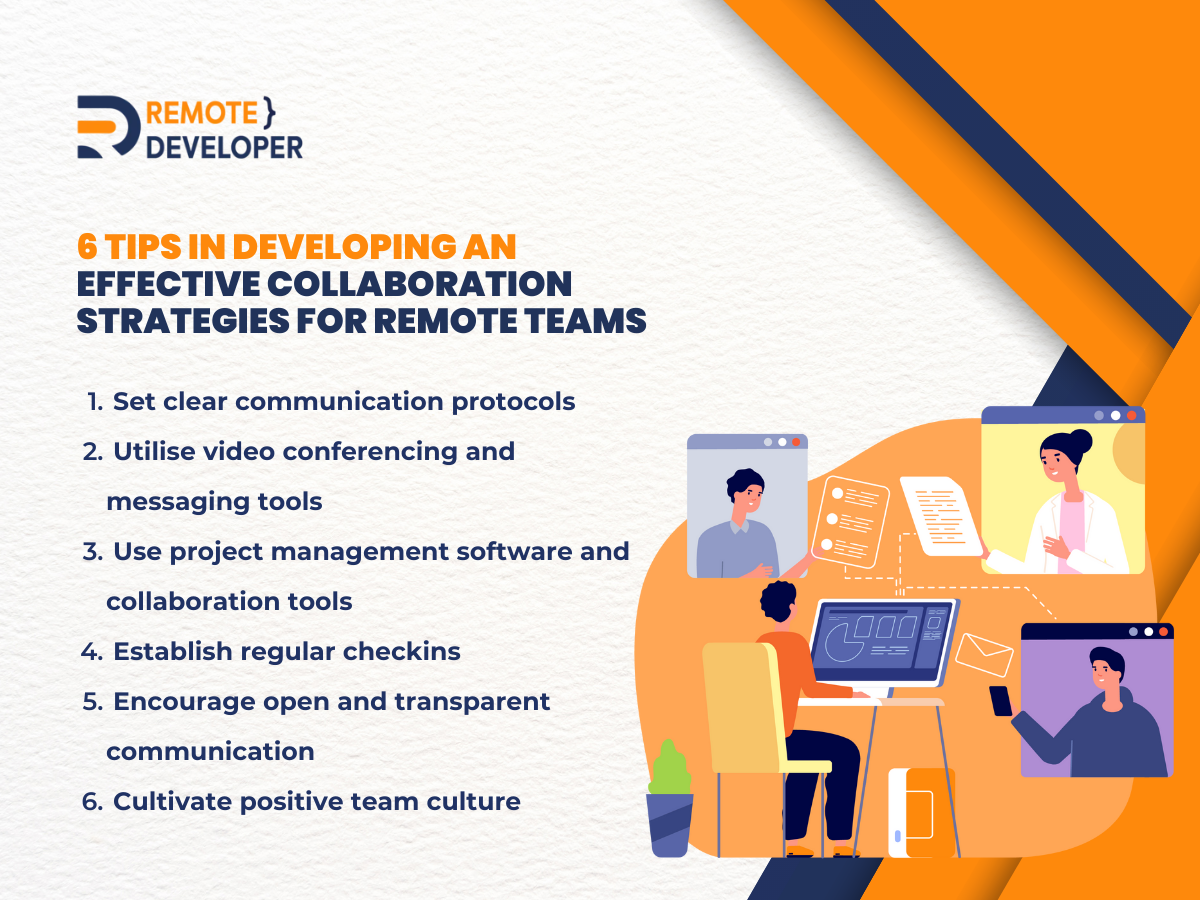As remote work remains more prevalent in today’s digital workforce, an effective remote environment has become essential to successful team collaboration. This is particularly true for remote development teams, where effective communication is crucial to ensure that projects are completed efficiently and effectively.
With remote team members located in different parts of the world, it can be challenging to maintain open lines of communication and ensure that everyone is on the same page. Therefore, developing effective communication strategies for remote development teams is essential to ensuring project success.
This article will explore remote team communication methods and strategies to help remote teams collaborate more efficiently and achieve their goals.
Challenges of Remote Development Team Communication
As mentioned earlier, remote development teams have gradually become prevalent in recent years, especially since the start of the pandemic. And while the economy opened and a few returned to work in the office, some companies remained working remotely due to its benefits, like reducing costs and flexibility.
Still, that doesn’t mean that remote working is perfect. This working mode also presents challenges, such as communication, that can hinder the team’s effectiveness. Here are some key issues a remote development team usually faces.
- Miscommunication and misunderstanding. Sometimes, a lack of face-to-face interaction can hinder communication between team members, leading to misunderstandings. The lack of non-verbal cues, such as body language and facial expressions, can make interpreting messages difficult.
- Time zone differences. When team members are in diverse time zones, scheduling meetings and coordinating work can be challenging. This can result in delays and miscommunications that affect the team’s productivity.
- Language barriers. Remote teams sometimes include members from different countries and cultures, which can result in language barriers that hinder effective communication. Differences in accents, colloquialisms, and grammar can all make it difficult to understand one another.
- Lack of access to information. When working remotely, team members may not have access to the same information as their colleagues who are working on-site. This can result in miscommunications and delays in decision-making.
- Overreliance on technology. Some remote team members rely heavily on technology to communicate, which can result in technical difficulties that hinder productivity. Poor internet connections, software glitches, and hardware malfunctions can disrupt communication and make it difficult to complete work on time.
How to build an effective remote team communication strategy?
To overcome these challenges, the remote team must develop an effective communication strategy and build trust among team members. This can include setting up regular meetings, creating clear and concise documentation, and utilising tools such as video conferencing and collaboration software.
In addition, remote development teams need to establish clear communication protocols, use collaboration tools that facilitate communication and collaboration, and establish a culture of transparency and openness.

1. Setting clear communication protocols
Establishing clear protocols is essential for remote team communication. Communication protocols can help ensure everyone is on the same page and understands how to connect effectively. Likewise, it will help the team stay organised and be aware of their tasks and deadlines and any changes or updates in the project.
Here are some ways you can set clear communication protocols:
- Define the purpose and scope of communication. Before setting communication protocols, it is crucial to define the purpose and scope of communication. This includes identifying who needs to communicate with whom and what information needs to be shared.
- Identify communication channels. Once you have a clear purpose and scope of communication, identify the communication channels used. This can include email, instant messaging, video conferencing, or project management software.
- Establish communication guidelines. Establish clear guidelines for communication, such as when to use each communication channel, how often to communicate, and the expected response time.
- Assign communication responsibilities to team members. Identify who will be responsible for communicating with clients or stakeholders.
- Provide training and support to team members. Discuss how to use communication channels effectively and how to follow communication protocols.
- Review and update protocols regularly. This will ensure that the protocols will remain relevant and practical.
2. Utilising video conferencing and screen sharing
Video conferencing tools revolutionise how remote teams communicate with their colleagues and customers. It allows for better team collaboration, brainstorming ideas, and making decisions quickly.
With these tools, you can converse with anyone worldwide without traveling. This means you can have a more meaningful and effective conversation without geographical barriers. Overall, video conferencing software is an excellent tool for your remote team communication strategy.
3. Using collaboration tools and project management software
In today’s world, collaboration tools and project management software are essential for remote team communication. These tools allow teams to stay connected and share information quickly and easily. They also provide a real-time platform for teams to collaborate on projects and tasks, ensuring that everyone is on the same page. With these tools, teams can ensure efficient and effective communications.
Here are some top collaboration tools for remote development teams:
- Slack. Slack is a common messaging app that allows teams to communicate in real time. It features channels for group discussions, direct messaging, file sharing, and integration with tools like Google Drive and Trello.
- Google Drive. Google Drive is a cloud-based storage app that allows teams to store, share, and collaborate on documents, spreadsheets, and presentations in real-time.
- Trello. Trello is a visual project management software that allows teams to manage tasks and projects on a virtual board. It features lists, cards, and checklists for tracking progress and deadlines.
- GitHub. GitHub is a code hosting and version control platform that allows teams to collaborate on software development projects. It features pull requests, code reviews, and issue tracking for managing code changes and project progress.
- Asana is also a project management software that allows teams to manage tasks, projects, and workflows. It features timelines, task lists, and team calendars for tracking progress and deadlines.
The right collaboration tool depends on the team’s specific needs and preferences, so choosing the best tools for your team is essential.
4. Establishing regular check-ins and status updates
Regular check-ins and status updates facilitate effective communication in remote development teams. It can also help to build stronger relationships between team members.
When team members work from different locations, it can be easy to feel isolated. So regular communication can help to create a sense of team spirit and camaraderie. By sharing updates and collaborating on projects, team members can develop a greater sense of trust and understanding, which can lead to improved communication and better project outcomes
In addition, working remotely can also cause difficulty staying up to date with the progress of projects and ensuring everyone is on the same page. Regular checkups can help team members communicate their progress, share any issues or challenges they face, and receive feedback and support from their colleagues.
These check-ins can take numerous forms, such as daily or weekly team meetings, one-to-one catch-ups between team members, or regular progress reports. During these check-ins, team members can discuss their progress, raise any issues, and collaborate on solutions to problems. This helps ensure everyone knows the project’s status and potential issues can be addressed early on.
5. Encouraging open and transparent communication
Open and transparent communication is essential for improving remote team communication. When team members are working from different places, it can be easy for misunderstandings and miscommunications to occur. By promoting open and transparent communication, team members can share their thoughts, concerns, and ideas more freely. These can help to prevent misunderstandings and build stronger relationships.
One way to promote open communication is to encourage team members to share their opinions and ideas openly. This can be done by creating a culture of respect and openness where everyone feels comfortable expressing their views. When team members feel heard and appreciated, they are more likely to contribute ideas and collaborate more effectively.
Another way to promote transparency is to share information openly and regularly. When team members have access to the same information, they are better equipped to collaborate effectively and make informed decisions. This can be achieved using collaboration tools such as project management software or shared documents, allowing team members to access and update information in real-time.
Communication strategies for remote team
6. Cultivating a Positive Team Culture
Positive team culture is critical for effective communication in remote development teams. Sometimes, when working remotely, it can be challenging to establish a sense of camaraderie and collaboration, which can negatively impact communication and project outcomes.
In addition, a positive team culture creates a supportive and collaborative environment where members feel appreciated and supported. This can help to foster trust and respect between team members, leading to more effective communication and collaboration.
To create a positive team culture, encourage remote team members to share their thoughts and opinions openly, leading to better decision-making and more creative solutions. This can be done by organising regular team-building activities, recognising individual contributions, and creating opportunities for team members to socialise and get to know each other.
Conclusion
In conclusion, developing effective communication strategies is critical for the success of remote development teams. Remote development teams face unique challenges when it comes to communication. Still, with the right system and tools in place, these challenges can be overcome. Effective communication can help to reduce misunderstandings and errors, improve productivity, and foster a positive team culture.
By prioritising effective communication and collaboration, remote development teams can work together more effectively, achieve better project outcomes, and foster a positive and supportive team culture.
And remember, effective communication is a continuous process that requires ongoing effort and refinement. So, invest in your team’s communication today and see its positive influence on your remote development team.
Like here at Remote Developer. We believe that effective remote team communication is the key to success. Contact us to learn how we foster efficient collaboration between our remote developers.

